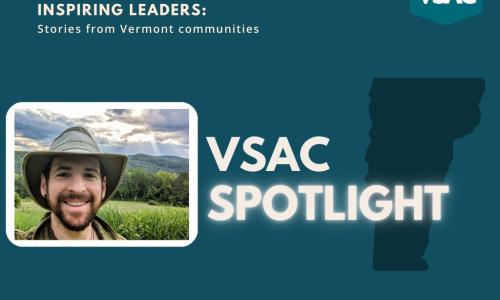Planning for college or training this year? Apply for the Vermont Grant.
A new year’s resolution guide for families and parents: 20 ways to help your student succeed

Over the 50 years of speaking with students who've completed high school and achieved their first early-adulthood goals, one common denominator has led to their success. Whether college admission, career training, or starting a job, adults close to them have shared their guidance, encouragement, and advice to help students succeed.
So, as we turn the page to 2024, we offer this list of “resolutions” for parents of middle- and high-school students. Keep in mind: It’s impossible to be a perfect parent and to do everything on this list. But the good news is, most parents and families are already offering support in many ways. And for many, there may be a few very simple things—or even just one—that parents can do now that make a big difference for their students in the long run. One of the things to remember is, you know your child. You can support them in the ways that matter most to their current and future goals.
Get involved
1. Attend school events, especially parent-teacher conferences. Meet your student’s teachers and school counselor. Students like to see that you can show up for them.
2. Discover the resources offered by the school counseling office, as well as VSAC’s Parent Resource Hub. Our Discover Parent Guide has information and resources that can support your student’s plans. It’s a helpful tool to use throughout middle and high school.
Support good study habits

3. Create a quiet and calm place for studying and homework.
4. Talk about strong learning habits, such as:
sitting in the front of the classroom
joining classroom discussions,
asking questions when they're unsure, and
submitting assignments (with careful review) before they’re due.
5. Observe and support your student at home as they complete an assignment or prepare for a test.
Ask them to show you their methods. You may be able to make suggestions that can improve their study skills. Follow up with them after they've come home:
How did they feel about the test?
What was their score?
What can they do differently next time?
Help students identify their interests and make career connections
6. Spark conversations about your student’s personality, likes and dislikes, non-academic interests, and what brings them joy. This will get them thinking about possible career fits down the road. Let them lead the conversation.
Introduce them to the options of early college or dual enrollment. Getting early college or career training credits or experiencing college or career training courses can be a great opportunity to explore their interests! School counselors can also support in making the connection.
7. Introduce them to people who have careers or jobs that they’re interested in. Support them by talking to professionals and setting up job shadowing opportunities.
8. Support them while they're choosing classes, extracurriculars, and even summer camps, jobs or volunteer work, that align with their interests.
Prepare for next steps after high school
9. Visit a college or tech-center campus together. Whether it's for a sports event or a performance, spend time getting comfortable and familiar with the new spaces.
10. Attend a college or career fair with your student, either in-person or virtually. Check out the NACAC college fair website for national college fairs.
Consider attending VSAC’s College and Career Pathways event for students and families on March 23 at the University of Vermont offers a free conference for sophomores, juniors, and parents.
11. Prepare for standardized tests. Although many schools are test-optional, success on standardized tests can help earn merit or institutional aid from higher education institutions.
For high school students, ask the school counseling office how your student should register for the SAT, ACT, TOEFL, or Accuplacer. For these tests, registration typically takes place in the spring.
For middle school students, learn about practice standardized tests, such as the PSAT or PreACT, which typically accept registrations in the fall. While including these test scores with school applications is now mostly optional, students may want to take them to see how they score, and whether their scores will enhance their applications.
12. Talk about the application and selection process for college or technical programs, and help them obtain those application materials. Learn more about what’s involved.
13. If you have a student in a tech center program, remind your student to talk to their school counselor about the credential(s) they can receive from their program and how to get it.
14. Research workforce development opportunities. VSAC, in partnership with other Vermont agencies, offers grants and interest-free forgivable loans to help eligible students afford the degree or career training they need to pursue their desired career. Options include forgivable loan programs in some of Vermont’s most in-demand career fields, such as:
nursing
teaching
nurse faculty, and
mental health care.
Students should also check out the 802Opportunity grant program, which allows any student with a family income of $75,000 or less to attend the Community College of Vermont tuition-free for two years.
Talk about money

15. Have the college cost conversation as early as needed. Use net price calculators such as College Scorecard to estimate what college might actually cost. But don't let the final costs deter you.
16. Start with financial aid. For most students, financial aid reduces the cost of attending a college, university, or career training program. Consider attending a “Financial Aid and Managing College Costs” presentation at your school in the spring and view VSAC's past financial aid videos. You can also view VSAC's calendar for upcoming financial aid events.
17. Consider opening a 529 savings account to save for future college and career training expenses. Even if your student is in middle school or high school, saving now can prepare you for their education opportunities.
VT529 is Vermont's official 529 plan, and you can open an account with $25. It’s easy for family and friends to contribute along the way. Plus, VT529 is the only plan that gives Vermont taxpayers a Vermont tax credit on their annual contributions to their 529 savings.
Once the student is ready to use the money for their education, 529 funds can be used for a wide variety of education-related expenses, including student housing, books and supplies, and student loan payments.
Prepare to file the FAFSA
The U.S. Department of Education has promised that the 2024/2025 FAFSA (Free Application for Federal Student Aid) will be available before December 31. The FAFSA is a requirement for almost all college financial aid programs, from loans to scholarships. While we’re all awaiting the form’s release, Resolutions 18 through 20 can help you prepare.
18. Create an FSA ID. A Federal Student Aid (FSA) ID is required to fill out the FAFSA. The student and at least one, or sometimes, both parents (or in FAFSA-speak, “contributors”) will each need their own individual FSA ID or Federal Student Aid account. While in the past, applicants for an FSA ID could use their username and password immediately to file a FAFSA, this year, the government is taking some additional verification steps in issuing FSA IDs.
People contributing information on a FAFSA must now wait 3-5 business days after creating an FSA ID for the government to confirm their ID can be used. VSAC counselors suggest that it's more important than ever that families do that part of the process now (it’s a short online process that takes about 10 minutes). And once you’re done, keep all usernames and passwords handy for when you're ready to fill out the FAFSA. If you need FAFSA help, visit our Focus on FAFSA resources to get answers and options to commonly asked questions.
19. Gather all the documents you’ll need for the FAFSA. Pull tax return files, print out investment statements, and have online passwords close by, so you’ll have your finances at your fingertips when you sit down to do the FAFSA. Depending on your personal circumstances, you may need your 2022 income tax returns, records of investments and assets, child support information, and bank statements.
20. Research grants and scholarships. Two of the best resources for Vermont students are the Vermont Grant and the 150-plus VSAC-managed scholarships, available to Vermont residents and students attending school in Vermont. You can (and should) peruse those applications now! Keep in mind that when you apply for any of these programs, you’ll also need to submit the FAFSA.
If you're interested in other federal grant programs, including Pell grants, FSEOG grants, TEACH grants, and Iraq & Afghanistan service grants from the U.S. Department of Education, you automatically apply to these programs by filing your FAFSA. Learn more at VSAC's Grants page.
Whatever “to-dos” you put on your own list, the thing that means the most to your student is your involvement. It shows your student that you’re interested in their success and that you believe in them.
Here’s to a successful 2024!






